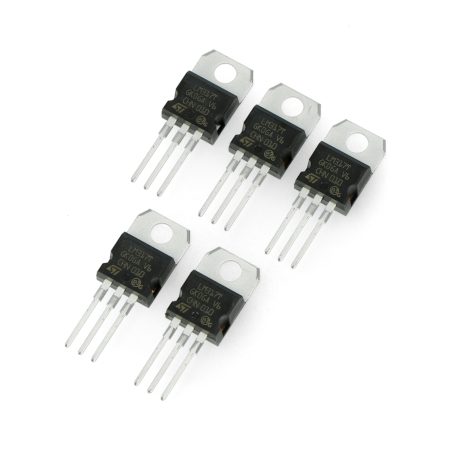Table of Contents:
The LM338 is a regulated linear voltage stabilizer that is distinguished by its ability to deliver current in excess of 5 A. It is a three-input device, which means it has 3 connections, namely input, output and regulation. As a result, it provides easy integration into various electronic circuits and systems. The LM338 chip can operate over an output voltage range of 1.2 V to 32 V, making it versatile in application. It is ideal for both low-voltage electronic circuit applications and systems requiring higher voltages. How is it built and what electrical parameters does it have?
LM338 design elements
The regulating transistor in the LM338 circuit is the main component responsible for stabilizing the output voltage. Its task is to maintain a constant voltage regardless of changes in the input voltage or the load. Thanks to this transistor, the circuit can provide a continuous, stable voltage to connected devices.
In turn, the control circuit in the LM338 monitors the output voltage and adjusts the operation of the regulating transistor to ensure its stability. It is a feedback system that responds to any deviation from the set output voltage and corrects it immediately. The control circuit is a key component that ensures the system’s high accuracy and response to changing operating conditions.
Other components of the LM338 linear stabilizer design
Thermal protection in the LM338 is designed to protect the circuit from damage caused by excessive heating. When the circuit temperature exceeds a safe threshold, the protection mechanism automatically reduces the output current or shuts down the circuit completely. This protection is extremely important in industrial applications where circuits are exposed to high temperatures.
The circuit is also equipped with surge protection, which is used to protect against harmful voltage spikes. Disturbances of this type can occur due to disturbances in the electrical grid or unexpected changes in the load. Such protections help keep the output voltage stable. In addition, they protect the circuit and connected devices from potential damage caused by surges.
LM338 applications
The LM338 is used in regulated power supplies that provide precise control of the output voltage. The ability to adjust the output voltage from 1.2 V to 32 V allows it to be used in various power supply configurations. What else is it used for?
- The LM338 is used in battery chargers. Its ability to deliver a stable and regulated voltage makes it ideal for applications requiring precise charging, such as lead and lithium-ion batteries.
- In addition, it is used in LED power systems. In such applications, it is necessary to have a stable output voltage to protect the diodes from overvoltages. In addition, the circuit ensures efficient operation of light sources.
What else is the LM338 chip used for?
In laboratories and test benches, the LM338 provides a stable power source for various measurement and test equipment. In audio devices (including amplifiers), the LM338 is used to supply power to analog parts, providing low noise and voltage stability.
The LM338 is also used in telecommunications systems, providing the stable and regulated power supply voltage necessary for the proper functioning of communication and data transmission devices.
Electrical parameters of the LM338
The electrical parameters of the adjustable LM338 voltage stabilizer are as follows:
- The chip can deliver a maximum of 5 amps, which is suitable for applications requiring higher loads.
- The stabilizer can accept up to 40 volts as input.
- The minimum voltage needed for the system to function properly is 4.2 volts.
- The maximum voltage that can be delivered at the output is 32 V.
- The minimum voltage that can be set at the output is 1.24 V.
Noise, idle current, thermal resistance and minimum load capacitance
The voltage noise level is a measure of unwanted voltage fluctuations in a circuit. For the LM338, it is 37 µVrms. This parameter is important in applications that require a high-precision power supply, especially in sensitive electronic components. The idle current is the current drawn by the voltage stabilizer at no load. In the case of the LM338 chip, it is 0.045 mA. Low idle current means less energy loss, which contributes to higher energy efficiency.
Thermal resistance determines how well the chip handles the heat generated during operation. For the LM338 chip, it is 23 °C/W. The minimum load capacitance, on the other hand, is the minimum value of the capacitor that can be connected to the voltage stabilizer output. For the LM338 chip, it is 0 µF, which means that the stabilizer can operate without an external capacitor at the output.
Other electrical parameters of the LM338 chip
The accuracy parameter determines with what precision the stabilizer maintains the set output voltage. For the LM338 chip, it is 2.4%, which means that the output voltage can differ from the set one by up to 2.4%.
The value of PSRR attenuation at 100 kHz indicates how well the circuit suppresses the effect of supply voltage changes on output voltage stability. For the LM338 circuit, this parameter is 10 dB. In practice, this means that at 100 kHz, supply voltage changes are attenuated by 10 dB. This value is particularly important in applications with supply voltage changes.
The typical voltage for the LM338 chip is 2700 mV. This parameter defines the expected voltage level for standard operating conditions. In other words, this is the basic output voltage value that the chip offers. The operating temperature range of 0 to 125°C ensures the versatility of the LM338 chip in various operating environments. Even when operating in applications with periodic or permanent high temperatures, the chip maintains stable performance.
How useful was this post?
Click on a star to rate it!
Average rating 0 / 5. Vote count: 0
No votes so far! Be the first to rate this post.




















